Factors, Policies, and Frameworks in Inclusive Practice Report
VerifiedAdded on 2022/11/28
|10
|3502
|265
Report
AI Summary
This report, prepared for the Level 5 Diploma in Education and Training (DET) Unit 417, investigates inclusive practice in education. It begins by examining the impact of personal, social, and cultural factors, such as age, gender, peer pressure, and cultural values, on student learning. The report then explores the influence of cognitive, physical, and sensory abilities, including reading skills, analytical skills, and various disabilities, on the learning process. Furthermore, it analyzes the role of policy and regulatory frameworks, such as the Equality Act 2010 and the Tomlinson model, in promoting inclusive practices. The report highlights the importance of treating all individuals equally, regardless of their background or abilities, and suggests strategies to support students with diverse needs, such as adapting teaching methods and creating inclusive learning environments. Finally, it emphasizes the role of teachers in fostering a supportive environment that enhances student understanding and learning outcomes.
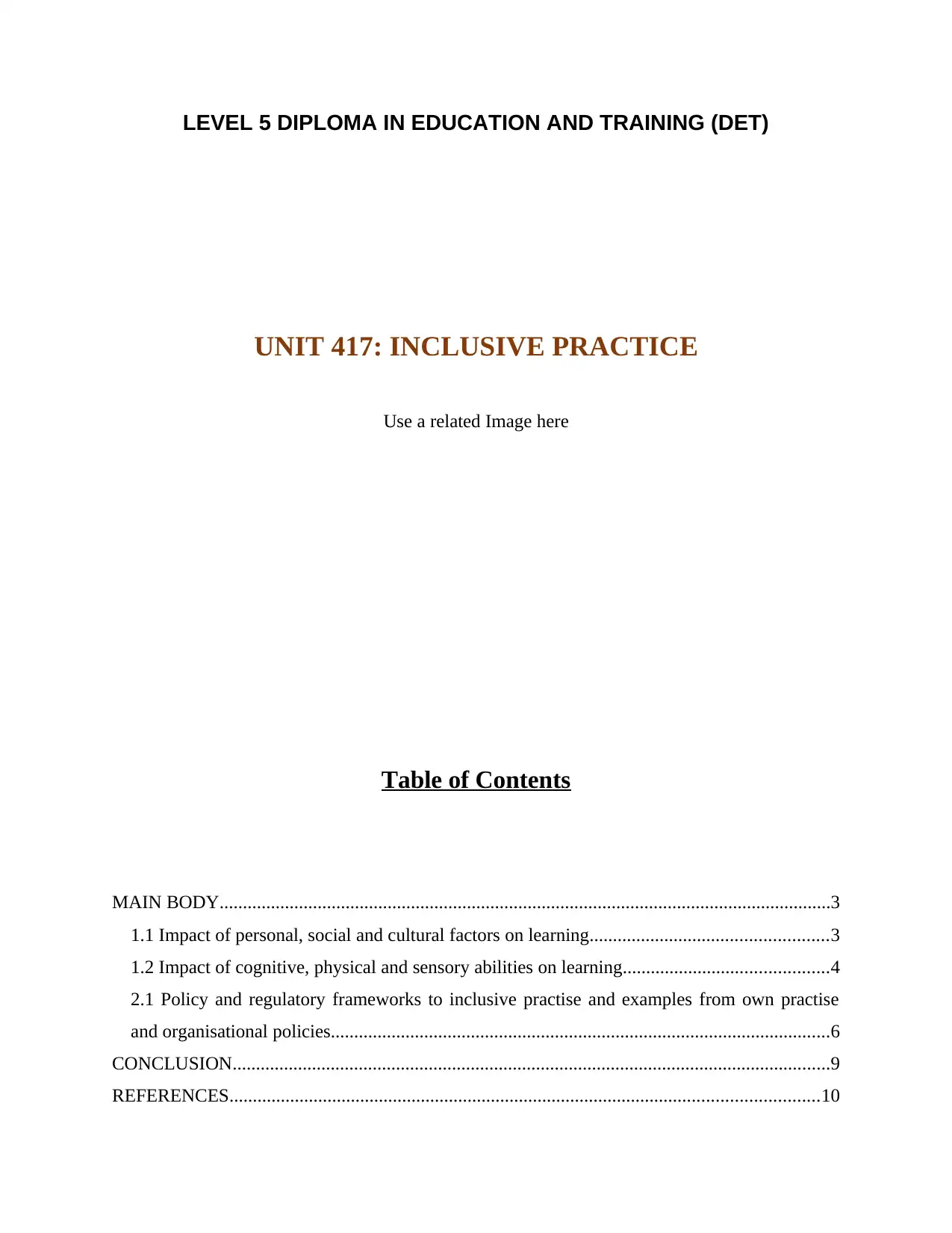
LEVEL 5 DIPLOMA IN EDUCATION AND TRAINING (DET)
UNIT 417: INCLUSIVE PRACTICE
Use a related Image here
Table of Contents
MAIN BODY...................................................................................................................................3
1.1 Impact of personal, social and cultural factors on learning...................................................3
1.2 Impact of cognitive, physical and sensory abilities on learning............................................4
2.1 Policy and regulatory frameworks to inclusive practise and examples from own practise
and organisational policies...........................................................................................................6
CONCLUSION................................................................................................................................9
REFERENCES..............................................................................................................................10
UNIT 417: INCLUSIVE PRACTICE
Use a related Image here
Table of Contents
MAIN BODY...................................................................................................................................3
1.1 Impact of personal, social and cultural factors on learning...................................................3
1.2 Impact of cognitive, physical and sensory abilities on learning............................................4
2.1 Policy and regulatory frameworks to inclusive practise and examples from own practise
and organisational policies...........................................................................................................6
CONCLUSION................................................................................................................................9
REFERENCES..............................................................................................................................10
Paraphrase This Document
Need a fresh take? Get an instant paraphrase of this document with our AI Paraphraser
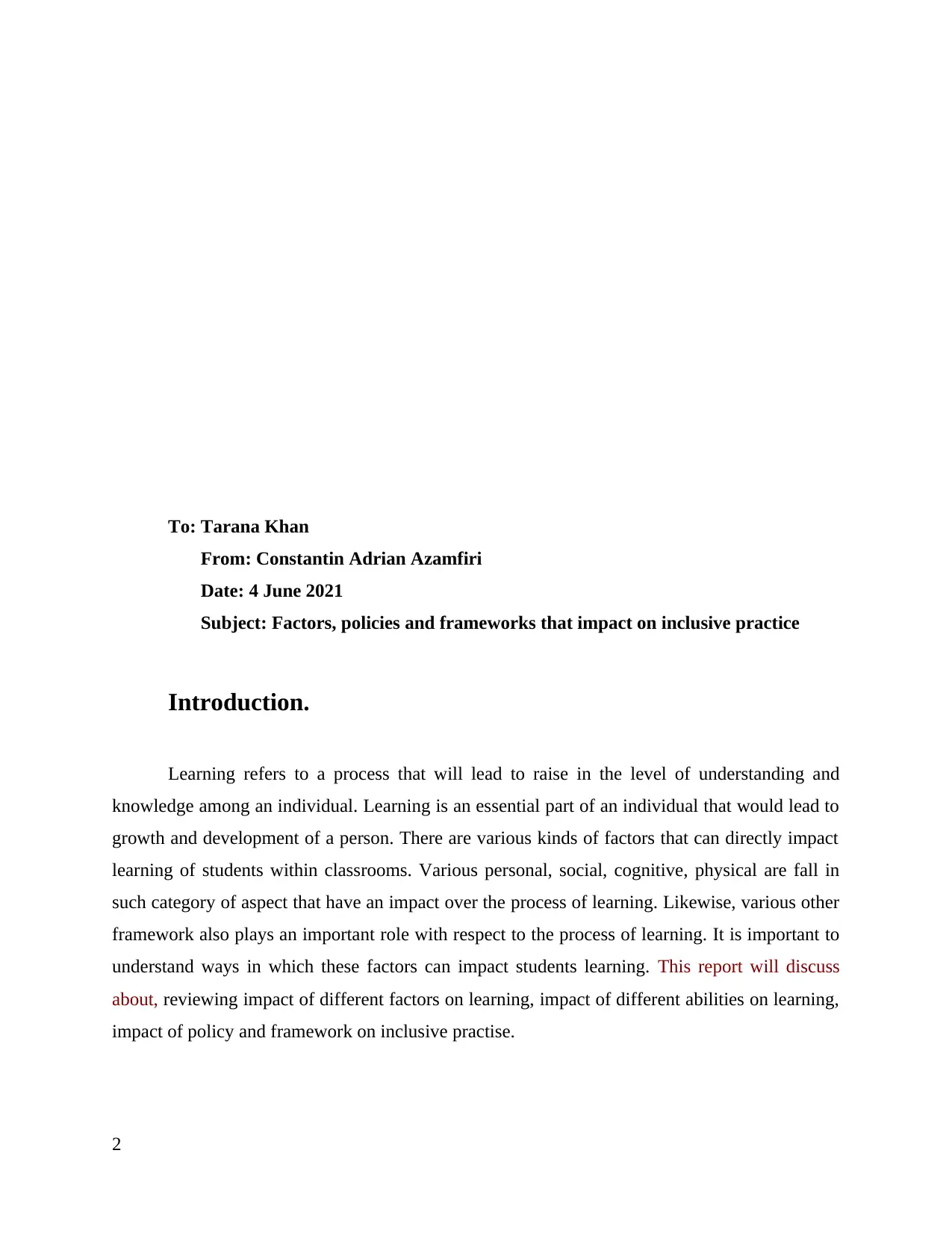
To: Tarana Khan
From: Constantin Adrian Azamfiri
Date: 4 June 2021
Subject: Factors, policies and frameworks that impact on inclusive practice
Introduction.
Learning refers to a process that will lead to raise in the level of understanding and
knowledge among an individual. Learning is an essential part of an individual that would lead to
growth and development of a person. There are various kinds of factors that can directly impact
learning of students within classrooms. Various personal, social, cognitive, physical are fall in
such category of aspect that have an impact over the process of learning. Likewise, various other
framework also plays an important role with respect to the process of learning. It is important to
understand ways in which these factors can impact students learning. This report will discuss
about, reviewing impact of different factors on learning, impact of different abilities on learning,
impact of policy and framework on inclusive practise.
2
From: Constantin Adrian Azamfiri
Date: 4 June 2021
Subject: Factors, policies and frameworks that impact on inclusive practice
Introduction.
Learning refers to a process that will lead to raise in the level of understanding and
knowledge among an individual. Learning is an essential part of an individual that would lead to
growth and development of a person. There are various kinds of factors that can directly impact
learning of students within classrooms. Various personal, social, cognitive, physical are fall in
such category of aspect that have an impact over the process of learning. Likewise, various other
framework also plays an important role with respect to the process of learning. It is important to
understand ways in which these factors can impact students learning. This report will discuss
about, reviewing impact of different factors on learning, impact of different abilities on learning,
impact of policy and framework on inclusive practise.
2
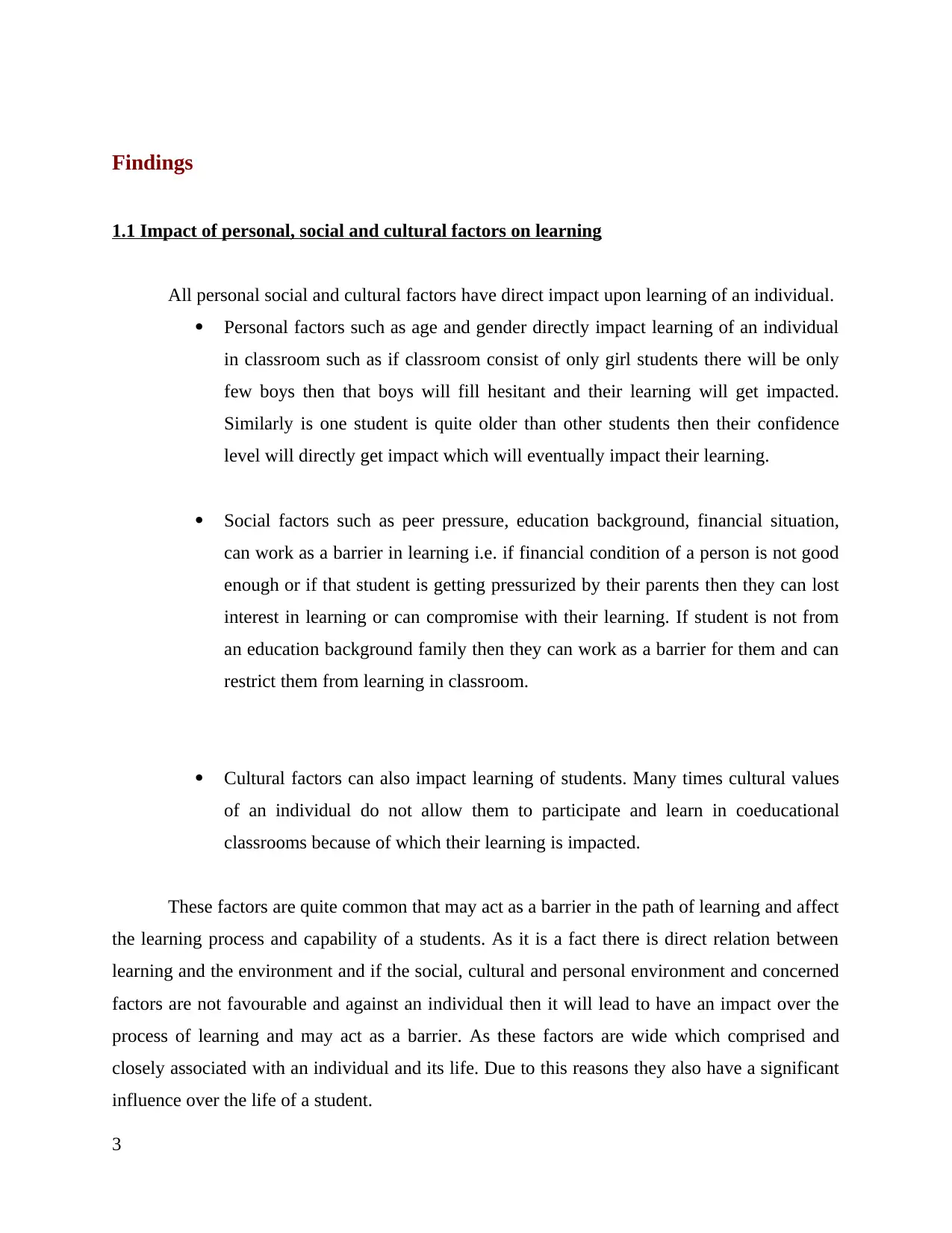
Findings
1.1 Impact of personal, social and cultural factors on learning
All personal social and cultural factors have direct impact upon learning of an individual.
Personal factors such as age and gender directly impact learning of an individual
in classroom such as if classroom consist of only girl students there will be only
few boys then that boys will fill hesitant and their learning will get impacted.
Similarly is one student is quite older than other students then their confidence
level will directly get impact which will eventually impact their learning.
Social factors such as peer pressure, education background, financial situation,
can work as a barrier in learning i.e. if financial condition of a person is not good
enough or if that student is getting pressurized by their parents then they can lost
interest in learning or can compromise with their learning. If student is not from
an education background family then they can work as a barrier for them and can
restrict them from learning in classroom.
Cultural factors can also impact learning of students. Many times cultural values
of an individual do not allow them to participate and learn in coeducational
classrooms because of which their learning is impacted.
These factors are quite common that may act as a barrier in the path of learning and affect
the learning process and capability of a students. As it is a fact there is direct relation between
learning and the environment and if the social, cultural and personal environment and concerned
factors are not favourable and against an individual then it will lead to have an impact over the
process of learning and may act as a barrier. As these factors are wide which comprised and
closely associated with an individual and its life. Due to this reasons they also have a significant
influence over the life of a student.
3
1.1 Impact of personal, social and cultural factors on learning
All personal social and cultural factors have direct impact upon learning of an individual.
Personal factors such as age and gender directly impact learning of an individual
in classroom such as if classroom consist of only girl students there will be only
few boys then that boys will fill hesitant and their learning will get impacted.
Similarly is one student is quite older than other students then their confidence
level will directly get impact which will eventually impact their learning.
Social factors such as peer pressure, education background, financial situation,
can work as a barrier in learning i.e. if financial condition of a person is not good
enough or if that student is getting pressurized by their parents then they can lost
interest in learning or can compromise with their learning. If student is not from
an education background family then they can work as a barrier for them and can
restrict them from learning in classroom.
Cultural factors can also impact learning of students. Many times cultural values
of an individual do not allow them to participate and learn in coeducational
classrooms because of which their learning is impacted.
These factors are quite common that may act as a barrier in the path of learning and affect
the learning process and capability of a students. As it is a fact there is direct relation between
learning and the environment and if the social, cultural and personal environment and concerned
factors are not favourable and against an individual then it will lead to have an impact over the
process of learning and may act as a barrier. As these factors are wide which comprised and
closely associated with an individual and its life. Due to this reasons they also have a significant
influence over the life of a student.
3
⊘ This is a preview!⊘
Do you want full access?
Subscribe today to unlock all pages.

Trusted by 1+ million students worldwide
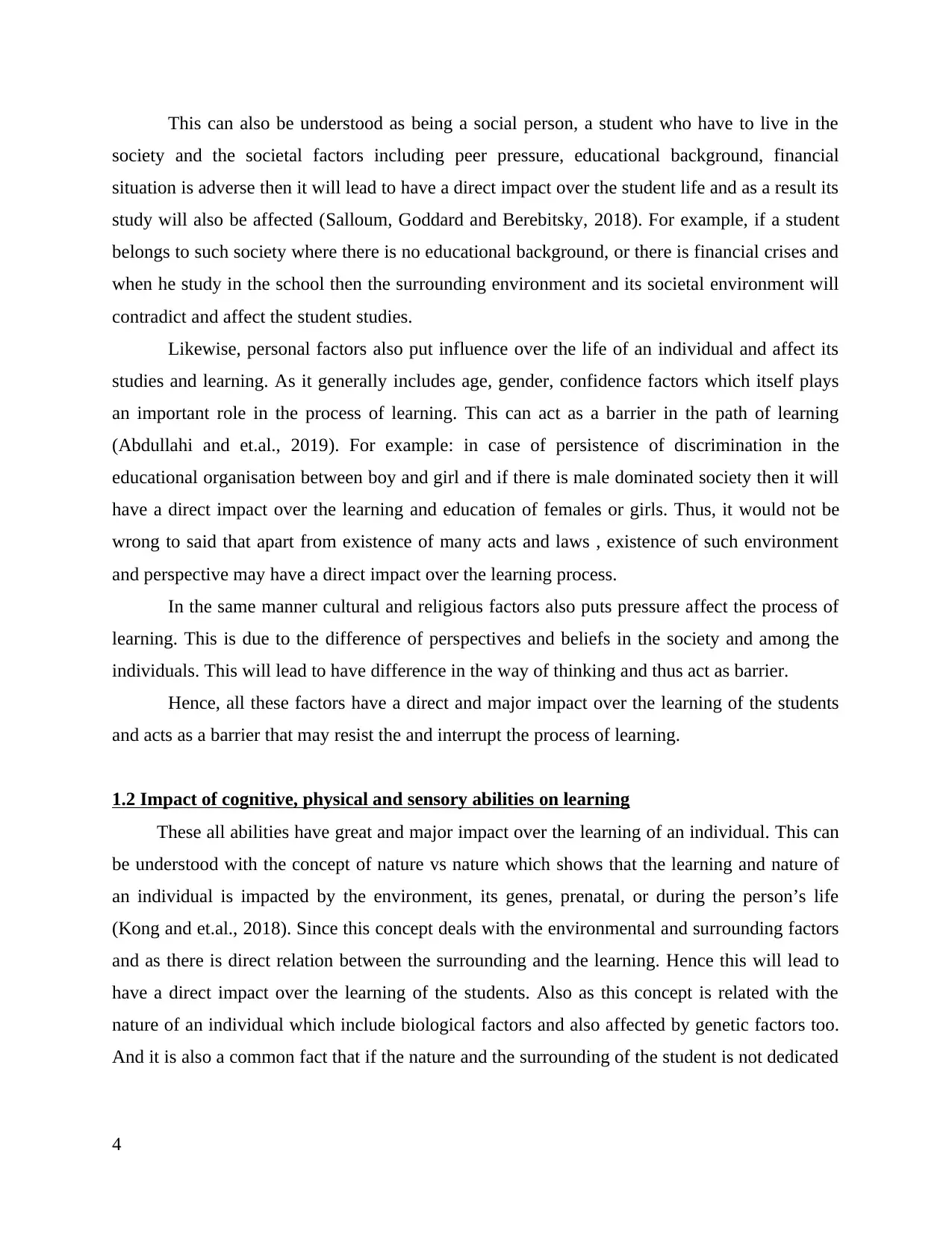
This can also be understood as being a social person, a student who have to live in the
society and the societal factors including peer pressure, educational background, financial
situation is adverse then it will lead to have a direct impact over the student life and as a result its
study will also be affected (Salloum, Goddard and Berebitsky, 2018). For example, if a student
belongs to such society where there is no educational background, or there is financial crises and
when he study in the school then the surrounding environment and its societal environment will
contradict and affect the student studies.
Likewise, personal factors also put influence over the life of an individual and affect its
studies and learning. As it generally includes age, gender, confidence factors which itself plays
an important role in the process of learning. This can act as a barrier in the path of learning
(Abdullahi and et.al., 2019). For example: in case of persistence of discrimination in the
educational organisation between boy and girl and if there is male dominated society then it will
have a direct impact over the learning and education of females or girls. Thus, it would not be
wrong to said that apart from existence of many acts and laws , existence of such environment
and perspective may have a direct impact over the learning process.
In the same manner cultural and religious factors also puts pressure affect the process of
learning. This is due to the difference of perspectives and beliefs in the society and among the
individuals. This will lead to have difference in the way of thinking and thus act as barrier.
Hence, all these factors have a direct and major impact over the learning of the students
and acts as a barrier that may resist the and interrupt the process of learning.
1.2 Impact of cognitive, physical and sensory abilities on learning
These all abilities have great and major impact over the learning of an individual. This can
be understood with the concept of nature vs nature which shows that the learning and nature of
an individual is impacted by the environment, its genes, prenatal, or during the person’s life
(Kong and et.al., 2018). Since this concept deals with the environmental and surrounding factors
and as there is direct relation between the surrounding and the learning. Hence this will lead to
have a direct impact over the learning of the students. Also as this concept is related with the
nature of an individual which include biological factors and also affected by genetic factors too.
And it is also a common fact that if the nature and the surrounding of the student is not dedicated
4
society and the societal factors including peer pressure, educational background, financial
situation is adverse then it will lead to have a direct impact over the student life and as a result its
study will also be affected (Salloum, Goddard and Berebitsky, 2018). For example, if a student
belongs to such society where there is no educational background, or there is financial crises and
when he study in the school then the surrounding environment and its societal environment will
contradict and affect the student studies.
Likewise, personal factors also put influence over the life of an individual and affect its
studies and learning. As it generally includes age, gender, confidence factors which itself plays
an important role in the process of learning. This can act as a barrier in the path of learning
(Abdullahi and et.al., 2019). For example: in case of persistence of discrimination in the
educational organisation between boy and girl and if there is male dominated society then it will
have a direct impact over the learning and education of females or girls. Thus, it would not be
wrong to said that apart from existence of many acts and laws , existence of such environment
and perspective may have a direct impact over the learning process.
In the same manner cultural and religious factors also puts pressure affect the process of
learning. This is due to the difference of perspectives and beliefs in the society and among the
individuals. This will lead to have difference in the way of thinking and thus act as barrier.
Hence, all these factors have a direct and major impact over the learning of the students
and acts as a barrier that may resist the and interrupt the process of learning.
1.2 Impact of cognitive, physical and sensory abilities on learning
These all abilities have great and major impact over the learning of an individual. This can
be understood with the concept of nature vs nature which shows that the learning and nature of
an individual is impacted by the environment, its genes, prenatal, or during the person’s life
(Kong and et.al., 2018). Since this concept deals with the environmental and surrounding factors
and as there is direct relation between the surrounding and the learning. Hence this will lead to
have a direct impact over the learning of the students. Also as this concept is related with the
nature of an individual which include biological factors and also affected by genetic factors too.
And it is also a common fact that if the nature and the surrounding of the student is not dedicated
4
Paraphrase This Document
Need a fresh take? Get an instant paraphrase of this document with our AI Paraphraser
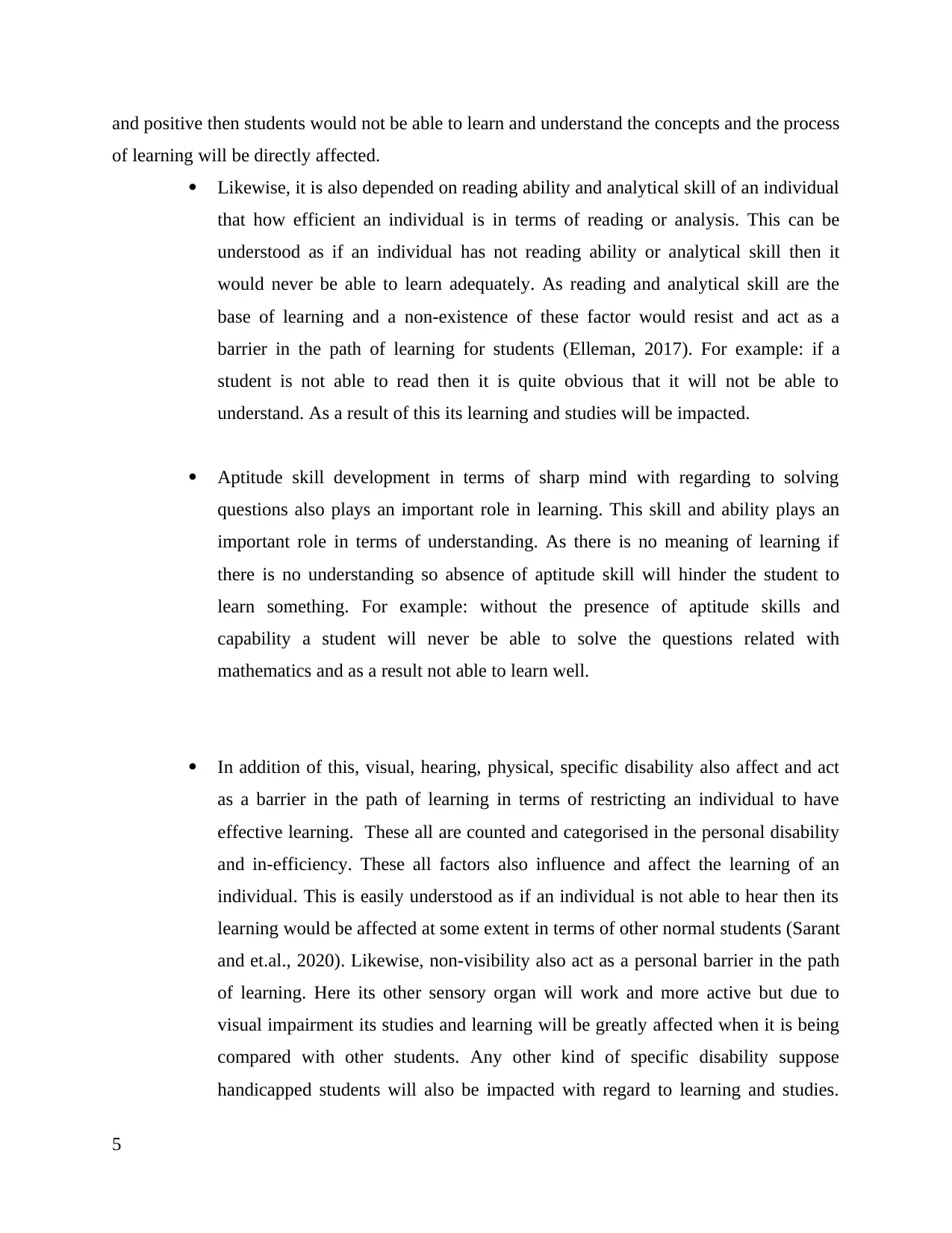
and positive then students would not be able to learn and understand the concepts and the process
of learning will be directly affected.
Likewise, it is also depended on reading ability and analytical skill of an individual
that how efficient an individual is in terms of reading or analysis. This can be
understood as if an individual has not reading ability or analytical skill then it
would never be able to learn adequately. As reading and analytical skill are the
base of learning and a non-existence of these factor would resist and act as a
barrier in the path of learning for students (Elleman, 2017). For example: if a
student is not able to read then it is quite obvious that it will not be able to
understand. As a result of this its learning and studies will be impacted.
Aptitude skill development in terms of sharp mind with regarding to solving
questions also plays an important role in learning. This skill and ability plays an
important role in terms of understanding. As there is no meaning of learning if
there is no understanding so absence of aptitude skill will hinder the student to
learn something. For example: without the presence of aptitude skills and
capability a student will never be able to solve the questions related with
mathematics and as a result not able to learn well.
In addition of this, visual, hearing, physical, specific disability also affect and act
as a barrier in the path of learning in terms of restricting an individual to have
effective learning. These all are counted and categorised in the personal disability
and in-efficiency. These all factors also influence and affect the learning of an
individual. This is easily understood as if an individual is not able to hear then its
learning would be affected at some extent in terms of other normal students (Sarant
and et.al., 2020). Likewise, non-visibility also act as a personal barrier in the path
of learning. Here its other sensory organ will work and more active but due to
visual impairment its studies and learning will be greatly affected when it is being
compared with other students. Any other kind of specific disability suppose
handicapped students will also be impacted with regard to learning and studies.
5
of learning will be directly affected.
Likewise, it is also depended on reading ability and analytical skill of an individual
that how efficient an individual is in terms of reading or analysis. This can be
understood as if an individual has not reading ability or analytical skill then it
would never be able to learn adequately. As reading and analytical skill are the
base of learning and a non-existence of these factor would resist and act as a
barrier in the path of learning for students (Elleman, 2017). For example: if a
student is not able to read then it is quite obvious that it will not be able to
understand. As a result of this its learning and studies will be impacted.
Aptitude skill development in terms of sharp mind with regarding to solving
questions also plays an important role in learning. This skill and ability plays an
important role in terms of understanding. As there is no meaning of learning if
there is no understanding so absence of aptitude skill will hinder the student to
learn something. For example: without the presence of aptitude skills and
capability a student will never be able to solve the questions related with
mathematics and as a result not able to learn well.
In addition of this, visual, hearing, physical, specific disability also affect and act
as a barrier in the path of learning in terms of restricting an individual to have
effective learning. These all are counted and categorised in the personal disability
and in-efficiency. These all factors also influence and affect the learning of an
individual. This is easily understood as if an individual is not able to hear then its
learning would be affected at some extent in terms of other normal students (Sarant
and et.al., 2020). Likewise, non-visibility also act as a personal barrier in the path
of learning. Here its other sensory organ will work and more active but due to
visual impairment its studies and learning will be greatly affected when it is being
compared with other students. Any other kind of specific disability suppose
handicapped students will also be impacted with regard to learning and studies.
5
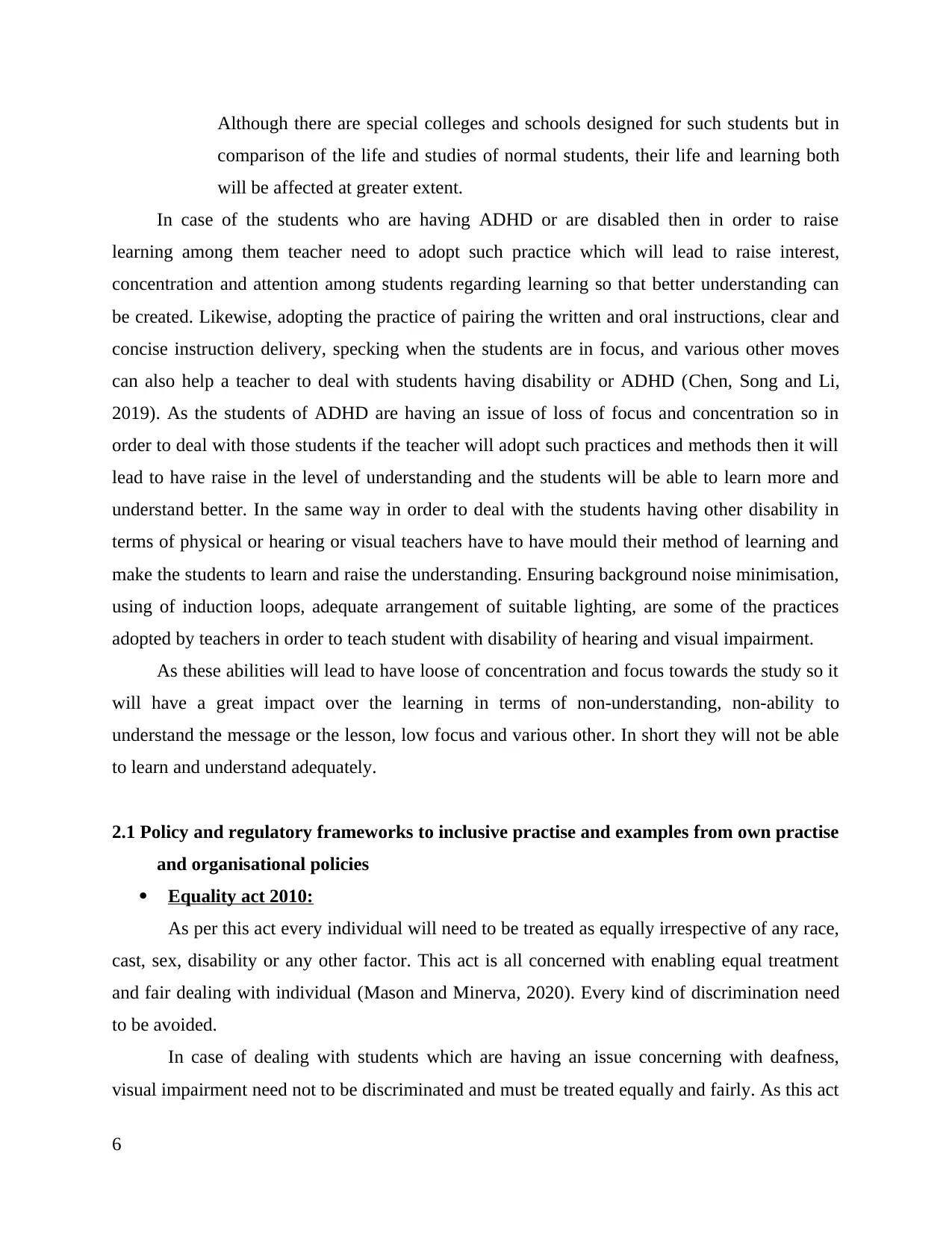
Although there are special colleges and schools designed for such students but in
comparison of the life and studies of normal students, their life and learning both
will be affected at greater extent.
In case of the students who are having ADHD or are disabled then in order to raise
learning among them teacher need to adopt such practice which will lead to raise interest,
concentration and attention among students regarding learning so that better understanding can
be created. Likewise, adopting the practice of pairing the written and oral instructions, clear and
concise instruction delivery, specking when the students are in focus, and various other moves
can also help a teacher to deal with students having disability or ADHD (Chen, Song and Li,
2019). As the students of ADHD are having an issue of loss of focus and concentration so in
order to deal with those students if the teacher will adopt such practices and methods then it will
lead to have raise in the level of understanding and the students will be able to learn more and
understand better. In the same way in order to deal with the students having other disability in
terms of physical or hearing or visual teachers have to have mould their method of learning and
make the students to learn and raise the understanding. Ensuring background noise minimisation,
using of induction loops, adequate arrangement of suitable lighting, are some of the practices
adopted by teachers in order to teach student with disability of hearing and visual impairment.
As these abilities will lead to have loose of concentration and focus towards the study so it
will have a great impact over the learning in terms of non-understanding, non-ability to
understand the message or the lesson, low focus and various other. In short they will not be able
to learn and understand adequately.
2.1 Policy and regulatory frameworks to inclusive practise and examples from own practise
and organisational policies
Equality act 2010:
As per this act every individual will need to be treated as equally irrespective of any race,
cast, sex, disability or any other factor. This act is all concerned with enabling equal treatment
and fair dealing with individual (Mason and Minerva, 2020). Every kind of discrimination need
to be avoided.
In case of dealing with students which are having an issue concerning with deafness,
visual impairment need not to be discriminated and must be treated equally and fairly. As this act
6
comparison of the life and studies of normal students, their life and learning both
will be affected at greater extent.
In case of the students who are having ADHD or are disabled then in order to raise
learning among them teacher need to adopt such practice which will lead to raise interest,
concentration and attention among students regarding learning so that better understanding can
be created. Likewise, adopting the practice of pairing the written and oral instructions, clear and
concise instruction delivery, specking when the students are in focus, and various other moves
can also help a teacher to deal with students having disability or ADHD (Chen, Song and Li,
2019). As the students of ADHD are having an issue of loss of focus and concentration so in
order to deal with those students if the teacher will adopt such practices and methods then it will
lead to have raise in the level of understanding and the students will be able to learn more and
understand better. In the same way in order to deal with the students having other disability in
terms of physical or hearing or visual teachers have to have mould their method of learning and
make the students to learn and raise the understanding. Ensuring background noise minimisation,
using of induction loops, adequate arrangement of suitable lighting, are some of the practices
adopted by teachers in order to teach student with disability of hearing and visual impairment.
As these abilities will lead to have loose of concentration and focus towards the study so it
will have a great impact over the learning in terms of non-understanding, non-ability to
understand the message or the lesson, low focus and various other. In short they will not be able
to learn and understand adequately.
2.1 Policy and regulatory frameworks to inclusive practise and examples from own practise
and organisational policies
Equality act 2010:
As per this act every individual will need to be treated as equally irrespective of any race,
cast, sex, disability or any other factor. This act is all concerned with enabling equal treatment
and fair dealing with individual (Mason and Minerva, 2020). Every kind of discrimination need
to be avoided.
In case of dealing with students which are having an issue concerning with deafness,
visual impairment need not to be discriminated and must be treated equally and fairly. As this act
6
⊘ This is a preview!⊘
Do you want full access?
Subscribe today to unlock all pages.

Trusted by 1+ million students worldwide
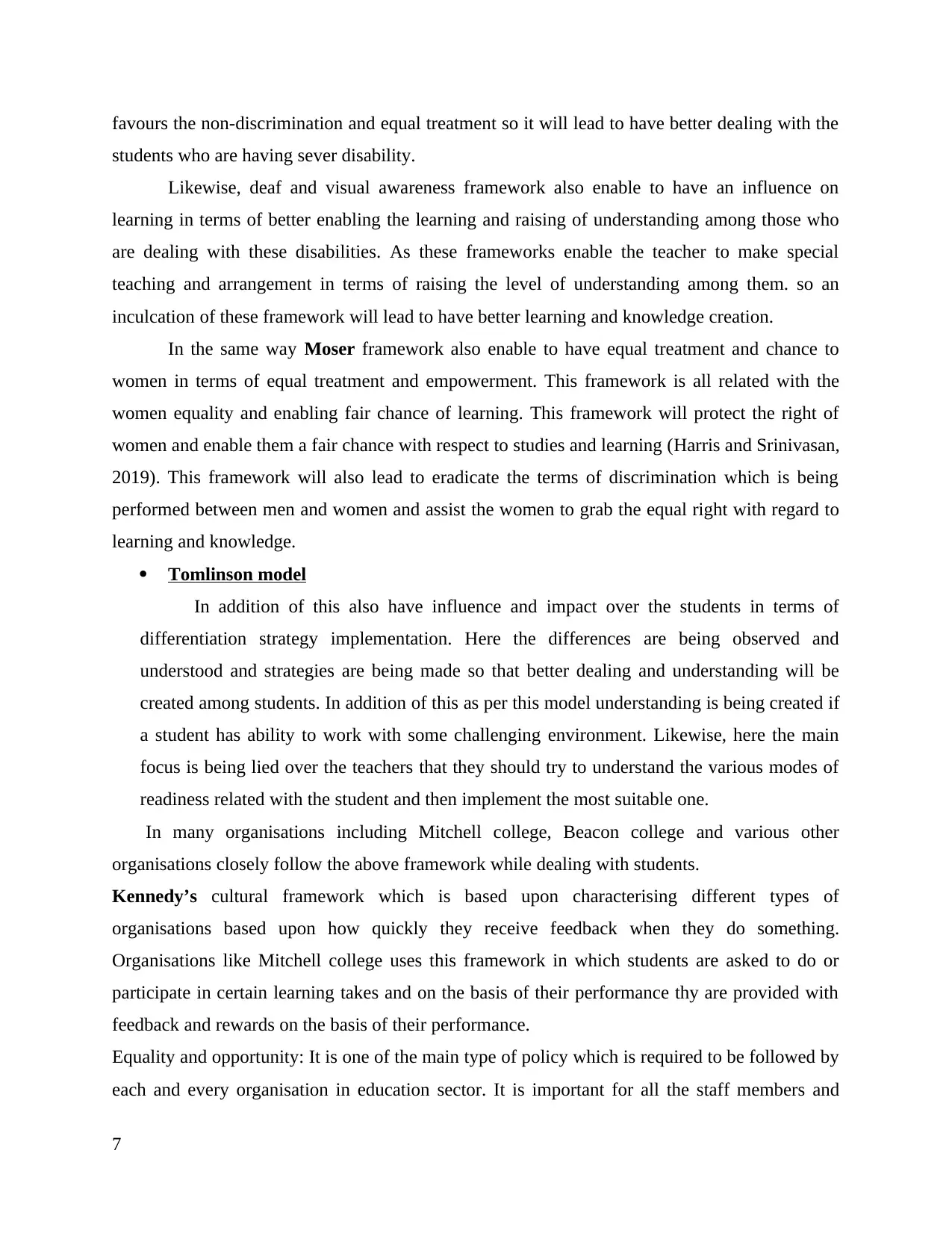
favours the non-discrimination and equal treatment so it will lead to have better dealing with the
students who are having sever disability.
Likewise, deaf and visual awareness framework also enable to have an influence on
learning in terms of better enabling the learning and raising of understanding among those who
are dealing with these disabilities. As these frameworks enable the teacher to make special
teaching and arrangement in terms of raising the level of understanding among them. so an
inculcation of these framework will lead to have better learning and knowledge creation.
In the same way Moser framework also enable to have equal treatment and chance to
women in terms of equal treatment and empowerment. This framework is all related with the
women equality and enabling fair chance of learning. This framework will protect the right of
women and enable them a fair chance with respect to studies and learning (Harris and Srinivasan,
2019). This framework will also lead to eradicate the terms of discrimination which is being
performed between men and women and assist the women to grab the equal right with regard to
learning and knowledge.
Tomlinson model
In addition of this also have influence and impact over the students in terms of
differentiation strategy implementation. Here the differences are being observed and
understood and strategies are being made so that better dealing and understanding will be
created among students. In addition of this as per this model understanding is being created if
a student has ability to work with some challenging environment. Likewise, here the main
focus is being lied over the teachers that they should try to understand the various modes of
readiness related with the student and then implement the most suitable one.
In many organisations including Mitchell college, Beacon college and various other
organisations closely follow the above framework while dealing with students.
Kennedy’s cultural framework which is based upon characterising different types of
organisations based upon how quickly they receive feedback when they do something.
Organisations like Mitchell college uses this framework in which students are asked to do or
participate in certain learning takes and on the basis of their performance thy are provided with
feedback and rewards on the basis of their performance.
Equality and opportunity: It is one of the main type of policy which is required to be followed by
each and every organisation in education sector. It is important for all the staff members and
7
students who are having sever disability.
Likewise, deaf and visual awareness framework also enable to have an influence on
learning in terms of better enabling the learning and raising of understanding among those who
are dealing with these disabilities. As these frameworks enable the teacher to make special
teaching and arrangement in terms of raising the level of understanding among them. so an
inculcation of these framework will lead to have better learning and knowledge creation.
In the same way Moser framework also enable to have equal treatment and chance to
women in terms of equal treatment and empowerment. This framework is all related with the
women equality and enabling fair chance of learning. This framework will protect the right of
women and enable them a fair chance with respect to studies and learning (Harris and Srinivasan,
2019). This framework will also lead to eradicate the terms of discrimination which is being
performed between men and women and assist the women to grab the equal right with regard to
learning and knowledge.
Tomlinson model
In addition of this also have influence and impact over the students in terms of
differentiation strategy implementation. Here the differences are being observed and
understood and strategies are being made so that better dealing and understanding will be
created among students. In addition of this as per this model understanding is being created if
a student has ability to work with some challenging environment. Likewise, here the main
focus is being lied over the teachers that they should try to understand the various modes of
readiness related with the student and then implement the most suitable one.
In many organisations including Mitchell college, Beacon college and various other
organisations closely follow the above framework while dealing with students.
Kennedy’s cultural framework which is based upon characterising different types of
organisations based upon how quickly they receive feedback when they do something.
Organisations like Mitchell college uses this framework in which students are asked to do or
participate in certain learning takes and on the basis of their performance thy are provided with
feedback and rewards on the basis of their performance.
Equality and opportunity: It is one of the main type of policy which is required to be followed by
each and every organisation in education sector. It is important for all the staff members and
7
Paraphrase This Document
Need a fresh take? Get an instant paraphrase of this document with our AI Paraphraser
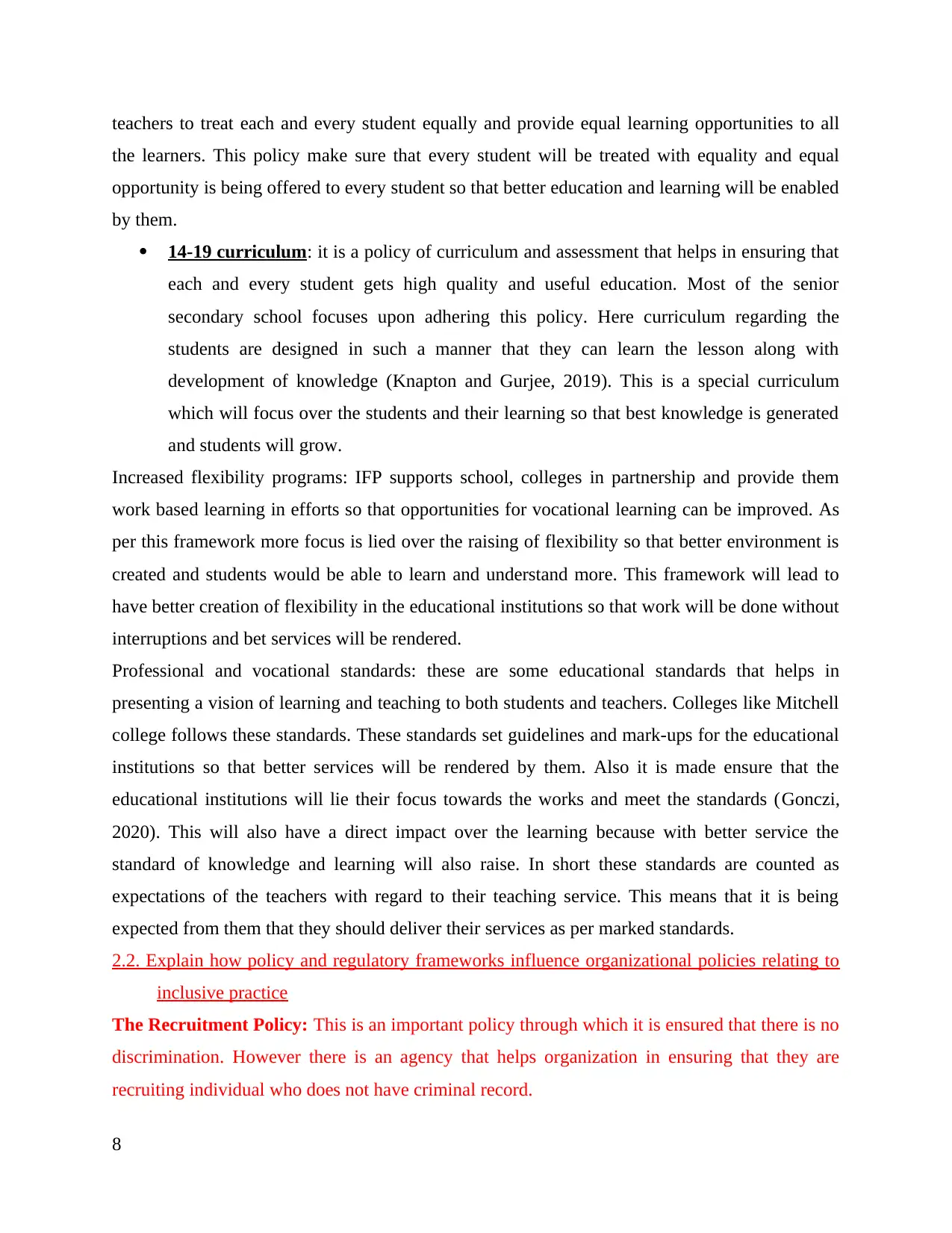
teachers to treat each and every student equally and provide equal learning opportunities to all
the learners. This policy make sure that every student will be treated with equality and equal
opportunity is being offered to every student so that better education and learning will be enabled
by them.
14-19 curriculum: it is a policy of curriculum and assessment that helps in ensuring that
each and every student gets high quality and useful education. Most of the senior
secondary school focuses upon adhering this policy. Here curriculum regarding the
students are designed in such a manner that they can learn the lesson along with
development of knowledge (Knapton and Gurjee, 2019). This is a special curriculum
which will focus over the students and their learning so that best knowledge is generated
and students will grow.
Increased flexibility programs: IFP supports school, colleges in partnership and provide them
work based learning in efforts so that opportunities for vocational learning can be improved. As
per this framework more focus is lied over the raising of flexibility so that better environment is
created and students would be able to learn and understand more. This framework will lead to
have better creation of flexibility in the educational institutions so that work will be done without
interruptions and bet services will be rendered.
Professional and vocational standards: these are some educational standards that helps in
presenting a vision of learning and teaching to both students and teachers. Colleges like Mitchell
college follows these standards. These standards set guidelines and mark-ups for the educational
institutions so that better services will be rendered by them. Also it is made ensure that the
educational institutions will lie their focus towards the works and meet the standards (Gonczi,
2020). This will also have a direct impact over the learning because with better service the
standard of knowledge and learning will also raise. In short these standards are counted as
expectations of the teachers with regard to their teaching service. This means that it is being
expected from them that they should deliver their services as per marked standards.
2.2. Explain how policy and regulatory frameworks influence organizational policies relating to
inclusive practice
The Recruitment Policy: This is an important policy through which it is ensured that there is no
discrimination. However there is an agency that helps organization in ensuring that they are
recruiting individual who does not have criminal record.
8
the learners. This policy make sure that every student will be treated with equality and equal
opportunity is being offered to every student so that better education and learning will be enabled
by them.
14-19 curriculum: it is a policy of curriculum and assessment that helps in ensuring that
each and every student gets high quality and useful education. Most of the senior
secondary school focuses upon adhering this policy. Here curriculum regarding the
students are designed in such a manner that they can learn the lesson along with
development of knowledge (Knapton and Gurjee, 2019). This is a special curriculum
which will focus over the students and their learning so that best knowledge is generated
and students will grow.
Increased flexibility programs: IFP supports school, colleges in partnership and provide them
work based learning in efforts so that opportunities for vocational learning can be improved. As
per this framework more focus is lied over the raising of flexibility so that better environment is
created and students would be able to learn and understand more. This framework will lead to
have better creation of flexibility in the educational institutions so that work will be done without
interruptions and bet services will be rendered.
Professional and vocational standards: these are some educational standards that helps in
presenting a vision of learning and teaching to both students and teachers. Colleges like Mitchell
college follows these standards. These standards set guidelines and mark-ups for the educational
institutions so that better services will be rendered by them. Also it is made ensure that the
educational institutions will lie their focus towards the works and meet the standards (Gonczi,
2020). This will also have a direct impact over the learning because with better service the
standard of knowledge and learning will also raise. In short these standards are counted as
expectations of the teachers with regard to their teaching service. This means that it is being
expected from them that they should deliver their services as per marked standards.
2.2. Explain how policy and regulatory frameworks influence organizational policies relating to
inclusive practice
The Recruitment Policy: This is an important policy through which it is ensured that there is no
discrimination. However there is an agency that helps organization in ensuring that they are
recruiting individual who does not have criminal record.
8
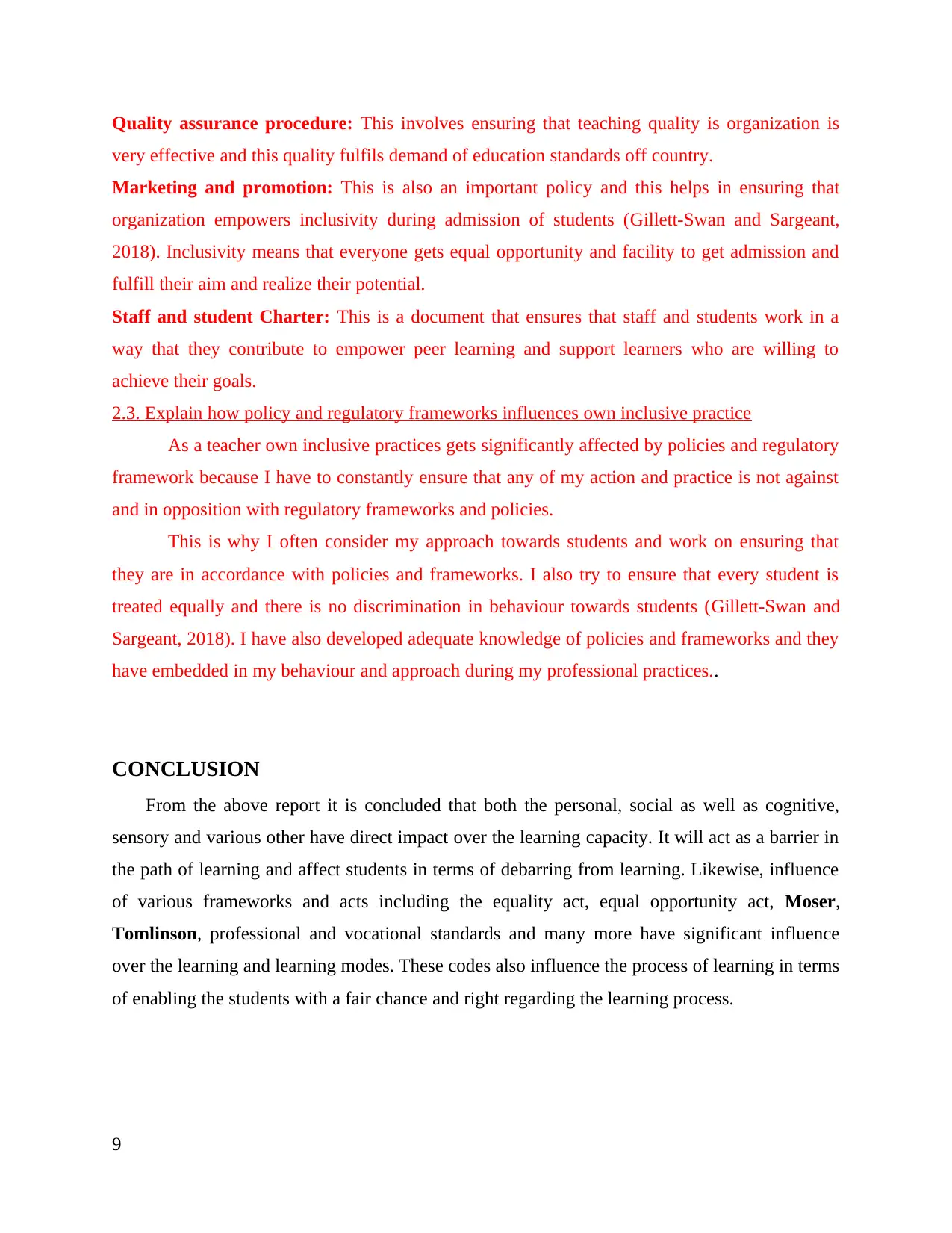
Quality assurance procedure: This involves ensuring that teaching quality is organization is
very effective and this quality fulfils demand of education standards off country.
Marketing and promotion: This is also an important policy and this helps in ensuring that
organization empowers inclusivity during admission of students (Gillett‐Swan and Sargeant,
2018). Inclusivity means that everyone gets equal opportunity and facility to get admission and
fulfill their aim and realize their potential.
Staff and student Charter: This is a document that ensures that staff and students work in a
way that they contribute to empower peer learning and support learners who are willing to
achieve their goals.
2.3. Explain how policy and regulatory frameworks influences own inclusive practice
As a teacher own inclusive practices gets significantly affected by policies and regulatory
framework because I have to constantly ensure that any of my action and practice is not against
and in opposition with regulatory frameworks and policies.
This is why I often consider my approach towards students and work on ensuring that
they are in accordance with policies and frameworks. I also try to ensure that every student is
treated equally and there is no discrimination in behaviour towards students (Gillett‐Swan and
Sargeant, 2018). I have also developed adequate knowledge of policies and frameworks and they
have embedded in my behaviour and approach during my professional practices..
CONCLUSION
From the above report it is concluded that both the personal, social as well as cognitive,
sensory and various other have direct impact over the learning capacity. It will act as a barrier in
the path of learning and affect students in terms of debarring from learning. Likewise, influence
of various frameworks and acts including the equality act, equal opportunity act, Moser,
Tomlinson, professional and vocational standards and many more have significant influence
over the learning and learning modes. These codes also influence the process of learning in terms
of enabling the students with a fair chance and right regarding the learning process.
9
very effective and this quality fulfils demand of education standards off country.
Marketing and promotion: This is also an important policy and this helps in ensuring that
organization empowers inclusivity during admission of students (Gillett‐Swan and Sargeant,
2018). Inclusivity means that everyone gets equal opportunity and facility to get admission and
fulfill their aim and realize their potential.
Staff and student Charter: This is a document that ensures that staff and students work in a
way that they contribute to empower peer learning and support learners who are willing to
achieve their goals.
2.3. Explain how policy and regulatory frameworks influences own inclusive practice
As a teacher own inclusive practices gets significantly affected by policies and regulatory
framework because I have to constantly ensure that any of my action and practice is not against
and in opposition with regulatory frameworks and policies.
This is why I often consider my approach towards students and work on ensuring that
they are in accordance with policies and frameworks. I also try to ensure that every student is
treated equally and there is no discrimination in behaviour towards students (Gillett‐Swan and
Sargeant, 2018). I have also developed adequate knowledge of policies and frameworks and they
have embedded in my behaviour and approach during my professional practices..
CONCLUSION
From the above report it is concluded that both the personal, social as well as cognitive,
sensory and various other have direct impact over the learning capacity. It will act as a barrier in
the path of learning and affect students in terms of debarring from learning. Likewise, influence
of various frameworks and acts including the equality act, equal opportunity act, Moser,
Tomlinson, professional and vocational standards and many more have significant influence
over the learning and learning modes. These codes also influence the process of learning in terms
of enabling the students with a fair chance and right regarding the learning process.
9
⊘ This is a preview!⊘
Do you want full access?
Subscribe today to unlock all pages.

Trusted by 1+ million students worldwide
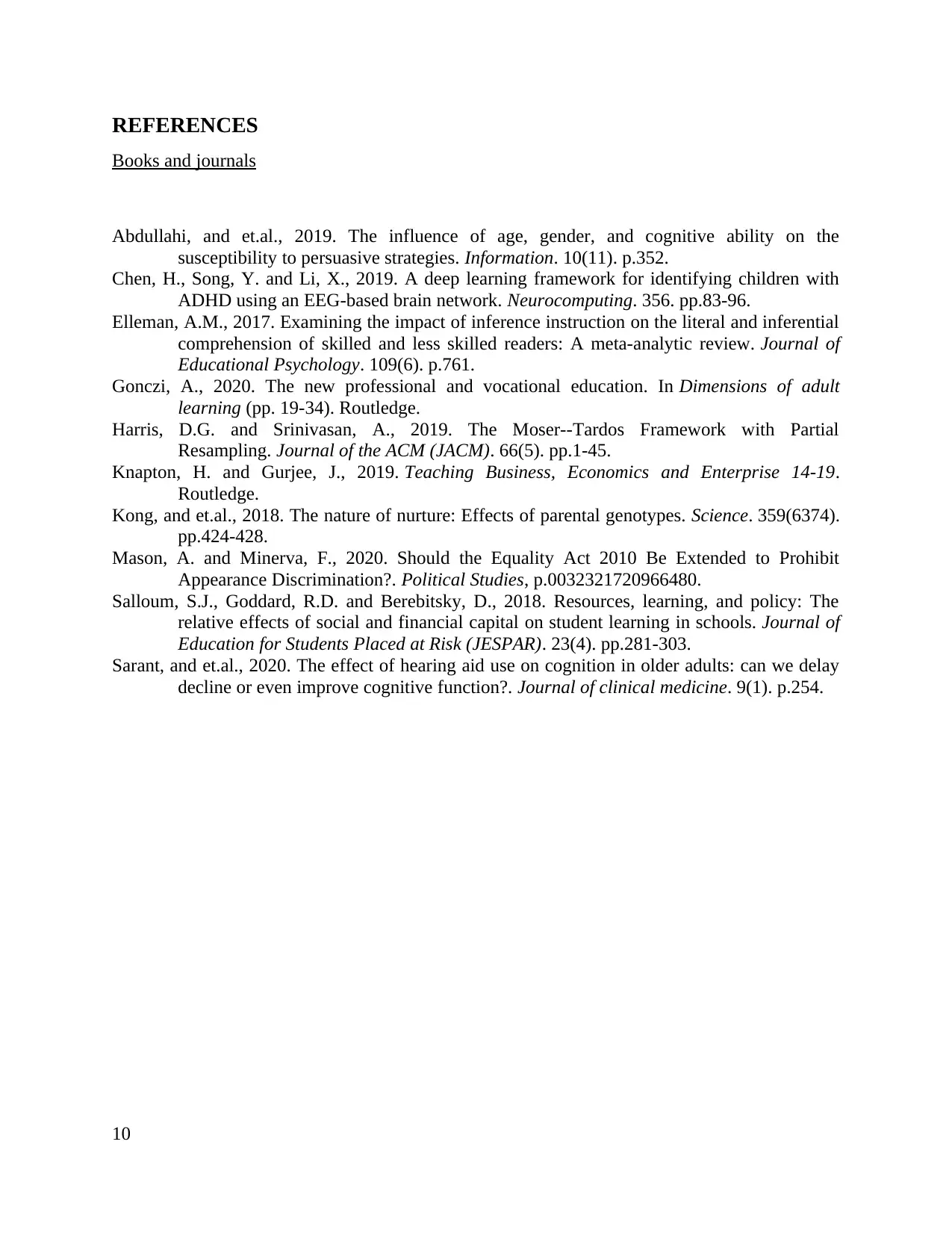
REFERENCES
Books and journals
Abdullahi, and et.al., 2019. The influence of age, gender, and cognitive ability on the
susceptibility to persuasive strategies. Information. 10(11). p.352.
Chen, H., Song, Y. and Li, X., 2019. A deep learning framework for identifying children with
ADHD using an EEG-based brain network. Neurocomputing. 356. pp.83-96.
Elleman, A.M., 2017. Examining the impact of inference instruction on the literal and inferential
comprehension of skilled and less skilled readers: A meta-analytic review. Journal of
Educational Psychology. 109(6). p.761.
Gonczi, A., 2020. The new professional and vocational education. In Dimensions of adult
learning (pp. 19-34). Routledge.
Harris, D.G. and Srinivasan, A., 2019. The Moser--Tardos Framework with Partial
Resampling. Journal of the ACM (JACM). 66(5). pp.1-45.
Knapton, H. and Gurjee, J., 2019. Teaching Business, Economics and Enterprise 14-19.
Routledge.
Kong, and et.al., 2018. The nature of nurture: Effects of parental genotypes. Science. 359(6374).
pp.424-428.
Mason, A. and Minerva, F., 2020. Should the Equality Act 2010 Be Extended to Prohibit
Appearance Discrimination?. Political Studies, p.0032321720966480.
Salloum, S.J., Goddard, R.D. and Berebitsky, D., 2018. Resources, learning, and policy: The
relative effects of social and financial capital on student learning in schools. Journal of
Education for Students Placed at Risk (JESPAR). 23(4). pp.281-303.
Sarant, and et.al., 2020. The effect of hearing aid use on cognition in older adults: can we delay
decline or even improve cognitive function?. Journal of clinical medicine. 9(1). p.254.
10
Books and journals
Abdullahi, and et.al., 2019. The influence of age, gender, and cognitive ability on the
susceptibility to persuasive strategies. Information. 10(11). p.352.
Chen, H., Song, Y. and Li, X., 2019. A deep learning framework for identifying children with
ADHD using an EEG-based brain network. Neurocomputing. 356. pp.83-96.
Elleman, A.M., 2017. Examining the impact of inference instruction on the literal and inferential
comprehension of skilled and less skilled readers: A meta-analytic review. Journal of
Educational Psychology. 109(6). p.761.
Gonczi, A., 2020. The new professional and vocational education. In Dimensions of adult
learning (pp. 19-34). Routledge.
Harris, D.G. and Srinivasan, A., 2019. The Moser--Tardos Framework with Partial
Resampling. Journal of the ACM (JACM). 66(5). pp.1-45.
Knapton, H. and Gurjee, J., 2019. Teaching Business, Economics and Enterprise 14-19.
Routledge.
Kong, and et.al., 2018. The nature of nurture: Effects of parental genotypes. Science. 359(6374).
pp.424-428.
Mason, A. and Minerva, F., 2020. Should the Equality Act 2010 Be Extended to Prohibit
Appearance Discrimination?. Political Studies, p.0032321720966480.
Salloum, S.J., Goddard, R.D. and Berebitsky, D., 2018. Resources, learning, and policy: The
relative effects of social and financial capital on student learning in schools. Journal of
Education for Students Placed at Risk (JESPAR). 23(4). pp.281-303.
Sarant, and et.al., 2020. The effect of hearing aid use on cognition in older adults: can we delay
decline or even improve cognitive function?. Journal of clinical medicine. 9(1). p.254.
10
1 out of 10
Related Documents
Your All-in-One AI-Powered Toolkit for Academic Success.
+13062052269
info@desklib.com
Available 24*7 on WhatsApp / Email
![[object Object]](/_next/static/media/star-bottom.7253800d.svg)
Unlock your academic potential
Copyright © 2020–2025 A2Z Services. All Rights Reserved. Developed and managed by ZUCOL.



